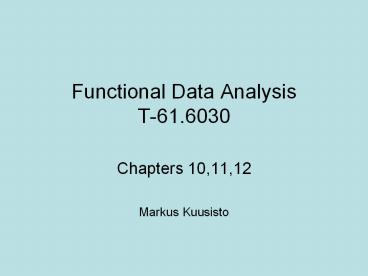Functional Data Analysis T-61.6030 PowerPoint PPT Presentation
Title: Functional Data Analysis T-61.6030
1
Functional Data Analysis T-61.6030
- Chapters 10,11,12
- Markus Kuusisto
2
Topics
- 10 PCA of mixed data
- 11 Canonical Correlation Analysis
- 12 Functional linear models
3
PCA of mixed data
- Both functional part and vector part (xi ,yi)
- Canadian temperature Registeration process finds
suitable shift. - - Vector part is size of shift
- - Functional part is shifted curve
4
Canadian temperature
5
Canadian temperature (shifted)
6
Using PCA, vector part yi
- yi are nuisance parameters -gt we ignore
- yi are marginal importance -gt we ignore them when
calculating PCA, but afterwards we investigate
connections between PCA scores and yi - yi are primary importance with functions xi -gt
we treat them as a hybrid data (xi ,yi)
7
The PCA of hybrid data
- PCA weight function (?,v)
- PCA score of particular observation
- ?i xi (s) ?(s) ds yi v
- inner product zi (xi , yi )
- ?z1 , z2 ? x1 x2 y1 y2
- To find leading principal component maximize
sample variance of the ?(?,v) , zi ? when
(?,v) 1
8
Balance between functional and vector variation
- Measure units between functional and vector parts
usually are not comparable - ?z1 , z2 ? x1 x2 C2 y1 y2
- Choice of C2
- C2 T , where T is interval of function xi
- C2 T / M, where M is length of y
- C2 Var(x) / Var(y)
9
Incorporating smoothing
- Roughness of z (x , y )
- - D2z (D2x, 0)
- - D2z 2 D2x 2
- Calculating like in chapter 9
10
Canonical Correlation Analysis
- CCA is a way of measuring the linear relationship
between two multidimensional variables - Ordinary correlation analysis is dependent on the
coordinate system in wich variables are described - CCA finds the coordinate system where the
correlation is maximized
11
Definition of CCA
- Consider the linear combination
- x xT wx y yT wy
- Function to be maximized is
- The maximum of ? with respect to wx and wy is
maximum canonical correlation - The number of solutions are limited to the
smallest dimensionality of x and y
12
Car marks example
13
CCA of car marks
- Correlation r1 0.9792 r2 0.8851
- wx1 wx2
- Price -0.4935 0.6887
- Value 0.8697 0.7251
- wy1 wy2
- Economy -0.5471 0.4693
- Service 0.2418 0.4496
- Design 0.0060 -0.0097
- Sport 0.5800 -0.0790
- Safety 0.2817 -0.0117
- Easy h. 0.4758 0.7558
14
(xTwx2 , yTwy2 )
15
Predicting by CCA
16
Learning
- wx corresponds output (x)
- wy corresponds 52 previous datapoints (y)
- Learning
- - Finding maximum canonical correlation and its
weights wx , wy - - Linear line fitting
- Predicting output x is done by projecting y yT
wy - to fitted line.
17
Predicting recursively next 50 data points
18
Functional canonical correlation analysis
- Function to be maximized
- subject to constraints
- It is possible allways to find perfect
correlation - Maximization does not produce a meaningfult
result
19
Unsmoothed canonical variate weight function that
attain perfect correlation.
- A standard condition for classical CCA
- n gt p q 1,
- - n is number of samples
- - p is length of xi and q is lenght of yi
- In functional case p and q are infinite, no
unique solution - Overfitting
20
Smoothing
- Smoothing is essential
- Choice of ? can be done
- subjectively
- by leave one out cross validation, maximazing
squared correlation. (11.3.3) - ccorsq? calculated as above but with the
observation (Xi ,Yi) omited
21
- Smoothed canonical weight functions
22
Functional linear models
- Previous we have been exploring the variability
of a functional variables - Now we explore how much of variation is explained
by other variables - In calssical statistics we do that by linear
regression and the general linear models. - Now functional linear models
23
Precipitation example
- Preciptitation ( total rainfall) of particular
area - where i indexes the 35 weather stations
- Does the precipitation depend on temperature of
that area - Overfitting without smoothing
24
A Functional response and a functional
independent variable
- How does a precipitation profile depend on the
associated temperature profile ? - Concurrent Precipitation now depends only on the
temperature now - Annual Precipitation now depend on the
temperature of the whole year
25
- Short-term feed-forward For reasons of
parsimony, precipitation now depends on the
temperature over an interval back in time. - Local influence Precipitation now depends on the
temperature over an interval back in time and the
season (is it summer or winter ?)
26
Predicting derivatives
- Dynamic model Model is designed to explain a
derivative of some order - homogenous first order linear differential
equation - -nonhomogenous
- temperature in the equation is called forcing
function
27
References
- Book Functional Data Analysis, J.O.Ramsay,
B.W.Silverman - http//www.functionaldata.org/
- matlab toolbox for FDA
- http//www.imt.liu.se/magnus/cca/
- Classical Canonical Correlation Analysis
- Method about solving blind source separation
problem based on CCA - Matlab functions cca.m and ccabss.m
- http//www.quantlet.com/mdstat/scripts/mva/htmlboo
k/mvahtmlnode95.html - Car marks example
- You may get confused because results presented
here differs from the site above. Reason is that
in that site the first and second canonical
correlations are changed places. - http//www.estsp2007.org/
- Data of example Predicting by CCA

